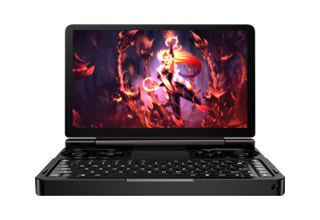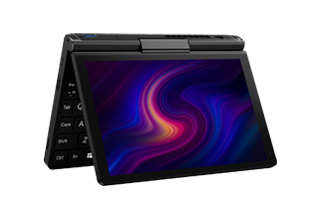GPD P2 Max presume de ser el «Ultrabook más pequeño del mundo»

GPD P2 Max, el «Ultrabook más pequeño del mundo» según lo califican sus creadores, es otro de esos desarrollos interesantes que nos llegan desde el crowdfunding, en este caso desde Indiegogo donde ha alcanzado casi el 1.000% de la cifra prevista para su comercialización.
GPD P2 Max destaca por un tamaño enormemente reducido, con una pantalla multitáctil con diez puntos de contacto; soporte para lápices ópticos; resolución nativa de 2560 x 1600 píxeles y 8,9 pulgadas de diagonal, que lo asemeja a un tablet de medio formato. Su peso es de solo 650 gramos y obviamente ofrece una gran movilidad.

Pero, cuidado, ésto es un PC en toda regla y con buenas características, comenzando por el procesador Intel de octava generación que incluye. Se apuesta por un modelo de dos núcleos y ocho hilos (frecuencia desde 1,1 a 3,4 GHz) Core M3-8100Y de ultrabajo voltaje para no disparar el consumo y permitir el sistema de refrigeración pasiva (sin molestos ventiladores) que incluye.
Estará disponible con 8 o 16 Gbytes de memoria RAM y opciones de almacenamiento interno basadas en SSD NVMe con hasta 1 Tbyte de capacidad.

Su conectividad no está nada mal para su tamaño. Dispone de Wi-Fi ac y Bluetooth, dos puertos USB-A de tamaño completo y otro USB Type-C.
GPD P2 Max preinstala Windows 10 Home y tiene un precio base de 531 dólares. Comenzará a enviarse a partir del próximo lunes 12 de agosto. Tiene buena pinta, por características y la enorme movilidad que permite el «Ultrabook más pequeño del mundo». Más información | Indiegogo
-
GPD Win Max 2 (2025) is a mini gaming laptop with Ryzen AI 9 HX 370
This week handheld PC maker GPD launched an updated version of its GPD Win 4 handheld gaming PC with a 6 inch display and an AMD Ryzen AI 9 HX 370 “Strix Point” processor, which should bring a significant performance boost over the Ryzen 7 8840U “Hawk Point” chip in the previous-generation model.
넶30 2024-12-17 -
GPD launches Win 4 handheld gaming PC with Ryzen AI 9 HX 370
The GPD Win 4 is a handheld gaming PC with a 6 inch FHD touchscreen display that slides upward to reveal a physical keyboard for thumb typing and a design that makes the handheld look like an oversized PlayStation Portable… if the PSP had a keyboard and support for modern PC games.
넶40 2024-12-17 -
GPD Pocket 4 is an 8.8 inch mini-laptop with up to AMD Ryzen AI 9 HX 370 (crowdfunding)
The GPD Pocket 4 is a mini-laptop with an 8.8 inch, 2560 x 1600 pixel, 144 Hz display, support for up to an AMD Ryzen AI 9 HX 370 “Strix Point” processor, and a convertible design that lets you twist the screen 180 degrees and fold it down over the keyboard for use in tablet mode.
넶37 2024-12-17 -
GPD announces official pricing for its Pocket 4 mini-laptops — The $1,466 unit packs 12-core Ryzen AI HX 370, 64GB of RAM, 2TB SSD, and 144Hz 2.5K display
Back in August, GPD announced the Pocket 4 mini laptop, which was supposedly the first handheld to employ AMD's latest Strix Point APUs. Following that, GPD Game Consoles has recently shared the pricing structure for these handhelds at X—starting at $895 with AMD's Zen 4-based Ryzen 7 8840U model and as high as $1,466 if you want the flagship Ryzen AI 9 HX 370 decked out with 64GB of RAM and 2TB of storage.
넶45 2024-12-13 -
GPD Duo Laptop Review: A Game-Changing Dual-Screen Powerhouse
In a world where innovation is key to staying ahead in technology, GPD has made a bold move with its latest offering—the GPD Duo, a dual-screen laptop powered by AMD’s cutting-edge Ryzen AI9 HX 370 processor. This is not your ordinary laptop. The dual-screen design, paired with top-tier specs and functionalities, makes the GPD Duo an exciting and versatile tool, particularly for professionals and tech enthusiasts. As a top content writer, I’ve seen how critical it is to balance innovation with
넶15 2024-12-13














